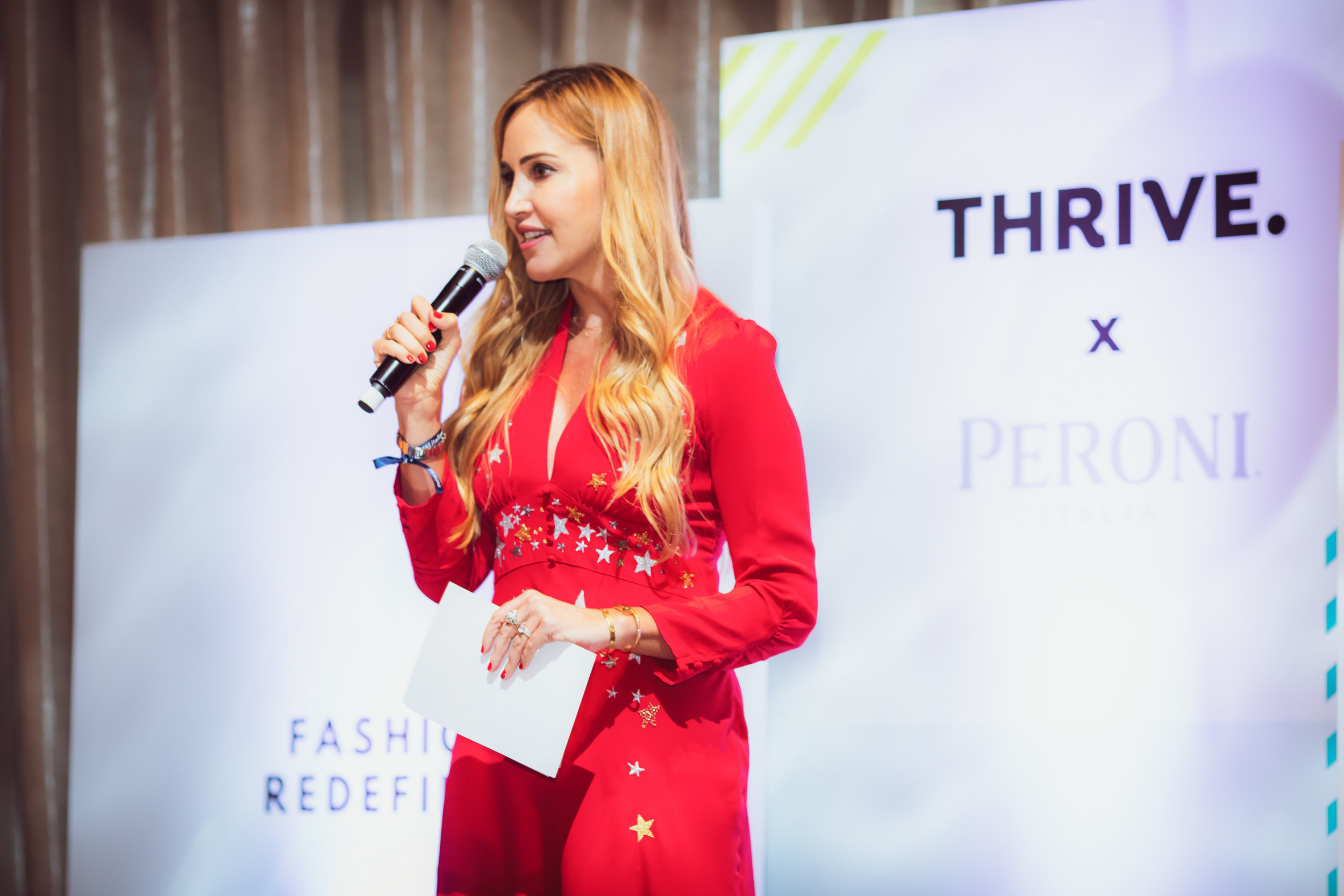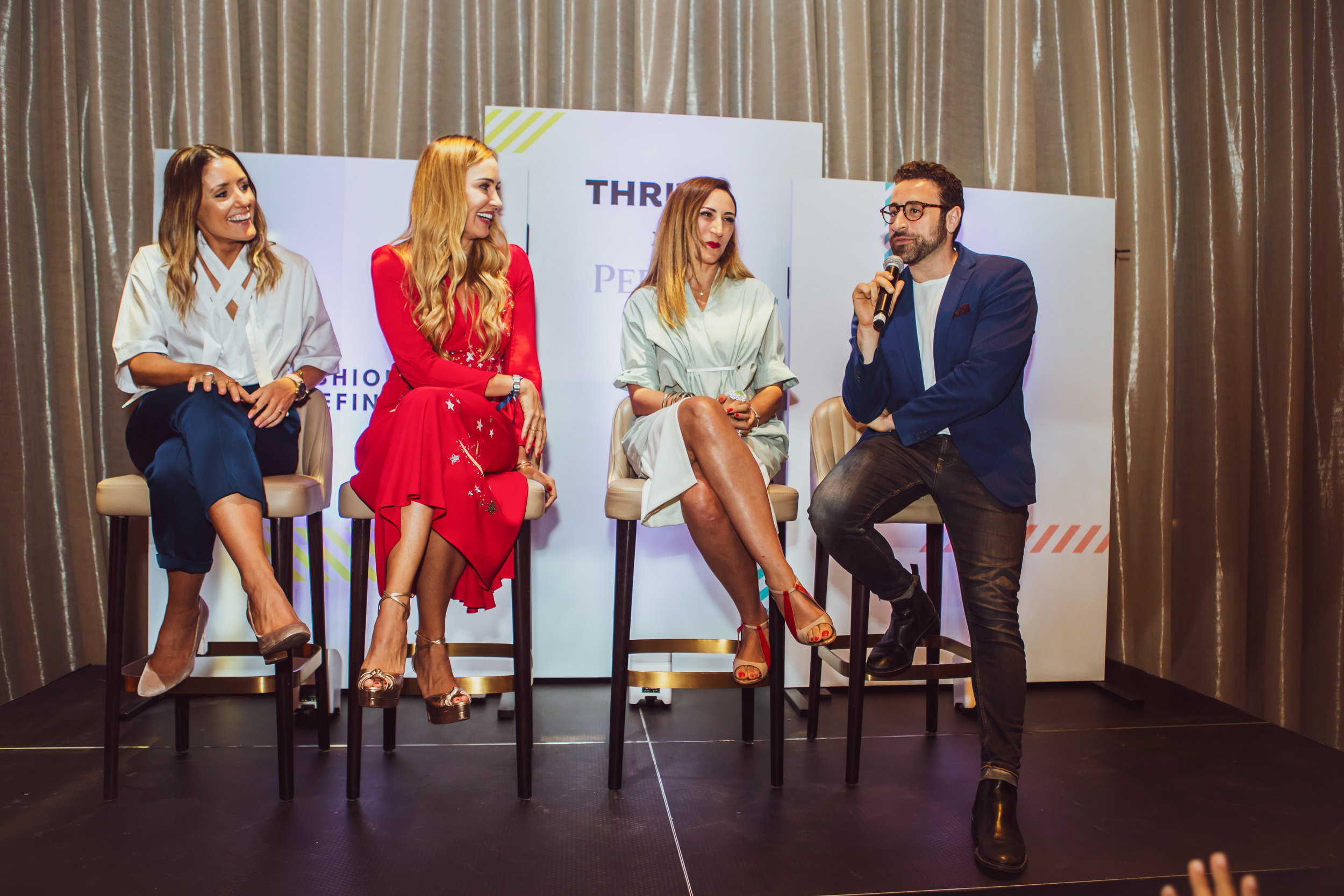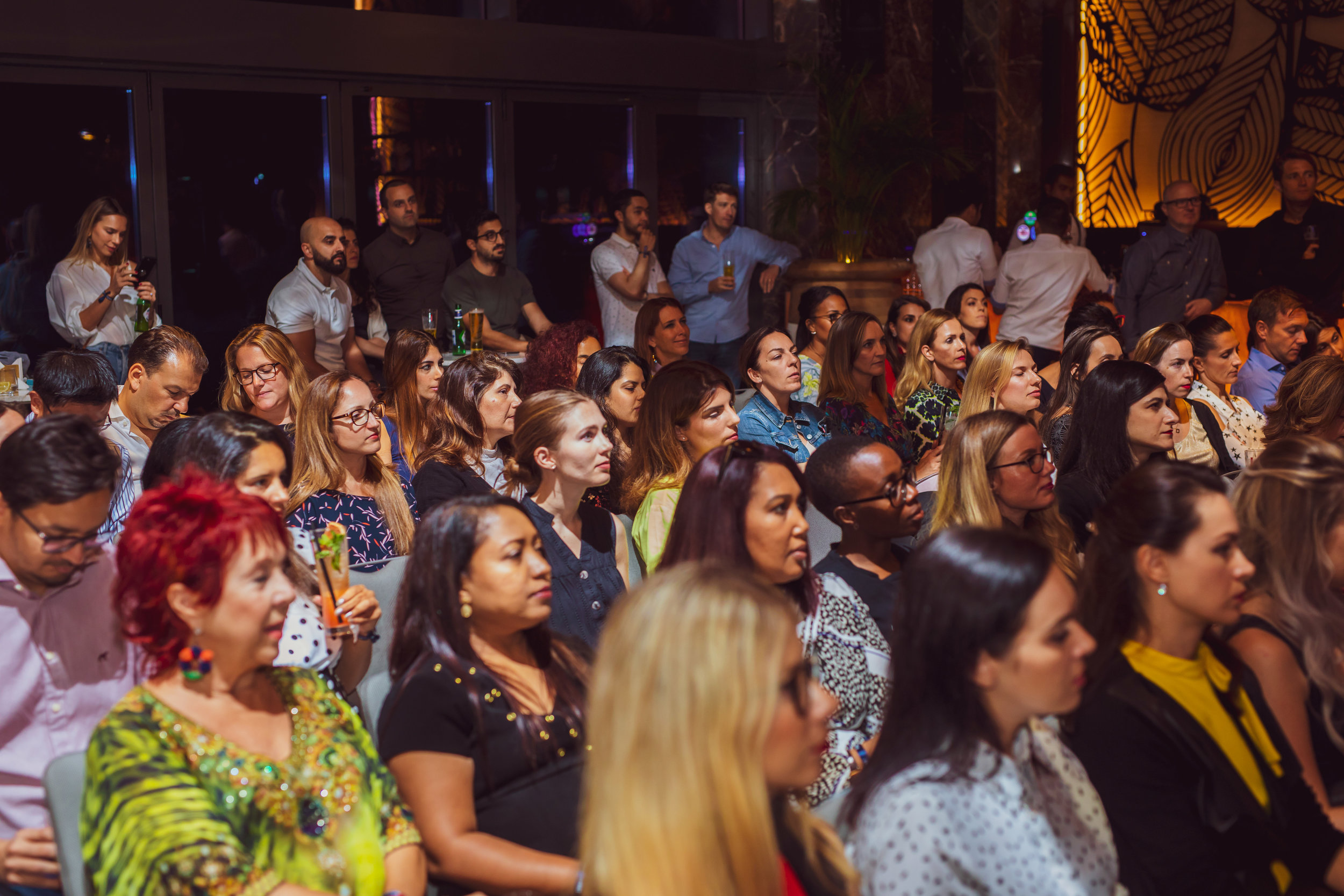I was honoured to be asked by Thrive Woman to talk at their ‘Fashion Redefined’ event held in Dubai at the end of April 2019. Thrive shares personal stories of ‘founders, leaders and innovators’ in the UAE with the aim of hopefully inspiring others. While I am no stranger to the mic, this was my first rodeo talking about myself and my beliefs - I am normally telling the story of another person or brand. It felt like a huge leap to open myself up personally and I am full of admiration for people who do this kind of thing regularly.
Side note: I didn’t even speak at my own wedding, although with hindsight, and some helpful #MeToo perspective, I do regret this. It was nine years ago now and I blindly followed tradition without questioning anything, like why is it only the men who speak?
Anyway, back to giving a speech that’s all about me. It’s fairly terrifying. That said I wanted to challenge myself to see whether I could compose and deliver a talk that might resonate with people, regardless of their involvement in the fashion industry or not.
Andrew kindly filmed the whole 14-min talk on his iPhone (excuse the hideous angle) which you can see here. For posterity, or if that angle is just too bad to suffer through, I have also added the transcription below.
Thanks, Thrive for firmly yanking me out of my comfort zone!
LNx
Images by Curly Wurly Photography
Re-friending Fashion
I love that Thrive called this talk Fashion Redefined, because I think if fashion needs anything, it needs redefining. I’m twisting that today and calling it re-friending fashion, for anyone who’s been tempted to hit the de-friend button on fashion – because I know I have.
My name is Louise Nichol and I have worked as a journalist covering fashion since the turn of the millennium – straight out of university – yep, that makes me feel really old. We’ll come back to why fashion sometimes makes me feel even older.
It’s a cliché, but I always wanted to be in fashion. I think this stems from growing up in a small seaside retirement town in England where style basically goes to die. We had a Tammy Girl – anyone remember Tammy Girl? There was also a C&A, whose stylistic high point was stocking the Global Hyper Colour T-shirts that changed colour with body heat. Remember them? So ’90s.
So for me, fashion brands were these unattainable, incredibly exotic signifiers of cool that meant you’d been on holiday to the States and come back with Tommy Hilfiger or Calvin Klein (the underwear, not the people). That just stuff didn’t exist on a small town UK high street in the ’90s.
So, I couldn’t get fashion, but I could get magazines. In my teens I used to buy Vogue religiously and I would scour the credits on fashion shoots. I didn’t necessarily have a critical eye for the images but I read those credits in minute detail. I wanted to know who the designers were, what the brands were. I thought that if I could namedrop the designers of the moment it would lend me a certain sophistication. In hindsight this was fairly ridiculous as the most glamorous thing in my wardrobe was a pair of purple Doc Martens. But I could pronounce Moschino. Literally no one cared.
So, how to get into fashion? This was pre-social media – it was pretty much pre-internet – so the fashion industry was far more distant and unattainable than it is today.
Well, I can’t draw, so that ruled out design. I’m not Cindy Crawford, so that knocked out modelling. I’m useless at the hard sell, so forget about retail.
What I can do, is write. And magazines and newspapers (they were kind of a big deal back then) needed people to write about trends and fashion. People who can spell Moschino.
I’m just going to pause for a moment and do a quick side-track. A couple of days ago I was talking to a friend about this speech, explaining that I’m far more comfortable telling other people’s stories than my own. And also that my own is pretty dull. I did everything the old fashioned way. I studied traditional subjects – an academic degree in politics, philosophy and English followed by a vocational post grad diploma in journalism – I got my first job through interning. And I got into fashion by being good at writing – I’m a demon with an apostrophe – not by being stylish.
“People would be interested in that,” my friend said encouragingly. But honestly I am not sure how relevant my experience is nowadays. Today, the ability to do a kickass beauty tutorial on YouTube can generate a better paid, more flexible career than being a doctor. Whether that’s right or wrong is a whole other debate. But in many cases it’s the truth.
Something that I’ve learned is that people of my generation who venerate traditional academic qualifications, classically lauded careers – medicine, law, finance, journalism – need to put our prejudices aside when we’re faced with teenage billionaires who appear to have made their money from taking pictures of their butt yet can’t get the apostrophe right in the caption. If we don’t at least try to understand this world, and ideally respect it, we’re just going to become irrelevant.
You know there came a point in the early 2010s – I was editing Harper’s Bazaar at the time – when applications for jobs on the magazine totally dried up. My publisher couldn’t understand why. I knew why. Why would you come and work at a magazine, doing long hours for low pay, with very little glory or glamour? Why? When you can probably earn more posting videos on YouTube and you get to lie in?
However, I digress. Back to my old-school route to, what was then my dream job.
So, after my politics degree – fun fact, British prime minister Theresa May comes from the same seaside town as me, I think given the current Brexit fiasco I had a lucky escape opting for Vivienne Westwood over Westminster – I did a post grad in journalism, then moved to London and became a fashion journalist.
Initially I wrote about the business of fashion for an industry magazine, which stood me in good stead as I was dealing with the business side of things rather than the fluff. My first boss said to me: “If you get sent a bunch of flowers from someone you have written a story about, you haven’t done your job properly.”
We weren’t there to spin PR, we were there to uncover hard news stories. This was to prove helpful when it came to cutting through the crap later in my career, and to remember that the real story isn’t always the one that your interviewee wants told.
About five years later, lured to Dubai by the lack of rain, tax and public transport, I ended up working for Grazia Middle East, which launched in October 2005. And in the summer of 2009 I was asked to become the editor-in-chief of Harper’s Bazaar Arabia, where I stayed for nine years until resigning last year, in 2018.
One thing that I hope really defines my time at both magazines is my determined focus on real women, and by real women I mean women whose primary job is not being paid to be in the public eye. In my last 12 months at Harper’s Bazaar Arabia we interviewed and photographed no fewer than 275 women from 13 Middle Eastern countries with professions including filmmakers, activists, mountaineers, athletes, humanitarians and many, many entrepreneurs.
Back in the Grazia days international editions were fuelled by street style shots of Kate Moss and Jennifer Aniston. We couldn’t do that here. We don’t have paparazzi roaming the streets and our style icons tend not to be models and actresses but ‘real women’. You guys. I used to send my Grazia team out to the malls with a photographer scouting stylish women to feature in our Style Hunter pages. Then, in my first year at Harper’s Bazaar, I launched Harper’s Bazaar Best Dressed. An annual book celebrating the most elegant, cool, inspirational Arab women from across the region. This focus on personal style took off. Today, it’s called Instagram.
So, what is personal style? Almost without fail, everyone we ask that question to for Harper’s Bazaar Best Dressed cites as their style icons: Audrey Hepburn, Jackie Onassis and Queen Rania of Jordan. But when you break down what Her Majesty Queen Rania, Jackie O and Audrey Hepburn actually wear, or wore, you find it’s timeless, elegant and fairly constant in silhouette. I am not sure that any of those women would have hopped on the trend for cycling shorts, bucket hats, boilers suits – maybe Jackie O would have done a tweed boiler suit – or seriously fugly Teva sandals. But if you want to rack up the likes on Instagram, that’s what you need to be wearing this season.
Increasingly, as I have got older, I have found myself more and more disconnected from ‘fashion’. And looking back, I think this goes back to those Vogue days as a teenager when I was reading the credits; I was interested in each item individually, trying to cut through the stylist’s vision and break down what was really going on and whether it was something I would want to wear.
I’ve realised that I love clothes – the physical items – but I am not that engaged by ‘fashion’ – as in the mood or the aesthetic. Maybe that’s why I was more interested in the origin of each piece in those shoots rather than the images themselves, genius as they may be. I am fascinated by what women buy, what we wear, and why… far more than an elaborate shoot in a magazine. Everyone says fashion’s purpose is to make you dream, and I don’t contest that. But words are what make me dream. Writing, stories… reading words, listening to words.
Making that distinction between clothes and fashion has been really healthy for me and certainly, I think, contributed to my decision to step away from my editor-in-chief role.
Another catalyst was when I interviewed a designer who probably had more impact on me that every other designer I’ve interviewed put together. And I have interviewed a lot of designers. This guy – you may not even have heard of him. His name is Ian Griffiths – does anyone know him?
Ian is the creative director of Max Mara, he’s Britsh, 57, and he used to be a punk. He works from this office in the middle of the Italian countryside, far away from Milan and all the glitzy shops and restaurants.
I’m not gonna lie, I wasn’t expecting much when I showed up to interview Ian. Here’s this former punk designing camel coats in a city that’s mainly famous for making Parmesan cheese, how interesting can he be? I thought. As it turns out, very interesting indeed.
This is what Ian told me about fashion: “Fashion designers force women into wearing things that are revealing and uncomfortable. I don’t want to do clothes that don’t enable you to feel like you deserve respect. I challenge fashion that makes people feel worse about themselves.”
I love that. “I challenge fashion that makes people feel worse about themselves.”
He said: “There’s a lot of stuff that you covet and you think, ‘Am I thin enough, am I young enough, am I cool enough?”
How often has fashion made you feel too fat, too old, too un-cool? I know it makes me feel that way all the time. And the rest of the time, it makes me feel not rich enough too. Nowadays, it also makes me feel not environmentally conscious enough either.
When this happens, fashion isn’t conjuring a dream, it’s engendering feelings that make us feel crap about ourselves. And that’s why I think fashion needs redefining.
It needs refocusing away from what’s ‘in fashion’ to what makes you feel amazing. Most of the stuff I love, really love; the things that feel effortless but are empowering and, I think, look good, are not in any way fashionable. They are not going to go viral on Instagram. But they feel right. They just work.
When I find myself contemplating cycling shorts with a bum bag slung over my shoulder and a leather beret and some tiny sunglasses because, you know, the ’Gram, I now think of Ian, the Max Mara designer, who said to me of his customer: “I think of her as a friend. I would never want to make her wear something that makes her feel ridiculous.”
“I think of her as a friend”
So, in conclusion, maybe that’s how we should view fashion: as a friend.
There to lift us up,
to make us feel secure,
to have our back,
to always say the right thing,
to fully support that second helping of cheesecake,
to be a confidence boost when we walk into a room full of strangers,
to always bring out the best in us,
to make us feel included – not excluded,
to be with us forever – not just for a season,
to grow older with us – but also to keep us young,
to make us feel we are okay just as we are (and not if we were just four kilos lighter)
and to always make us look great in photos.
If a new dress can do all of the above, then I am ready to re-friend fashion. Thank you!



